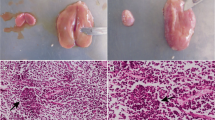Summary
A study was carried out to determine which materials from animals dying or dead of heartwater could initiate the disease in susceptible goats, using the intravenous and subcutaneous routes.C. ruminantium was consistently isolated by intravenous injection of the whole blood or of lung macrophages and by subcutaneous injection of brain homogenate. In animals dead of heartwater, it appeared that isolation of the organism was achieved only when extensive post-mortem autolysis had not supervened.
Experiments with blood fractions showed that leucocytic and plasma fractions of infective blood transmitted heartwater; the erythrocytic fraction consistently failed to induce an infection.
Résumé
Une étude a été faite pour déterminer quél matériel provenant d'animaux mourants ou morts de heartwater était capable de provoquer la maladie chez des chèvres sensibles, par voie intraveineuse ou sous-cutanée;Cowdria ruminantium a été régulièrement isolé par injection intraveineuse du sang total ou de macrophages pulmonaires et par voie sous cutanée par inoculation de broyats du cerveau.
Chez les animaux morts de heartwater, il est apparu que l'isolement de l'organisme n'était possible qu'avant le début de l'autolyse étenduepost mortem.
Des expériences avec des fractions sanguines ont montré que les fractions plasmatiques et leucocytaires du sang infecté ont transmis la heartwater; la fraction érythrocytaire n'a pas réussi de façon régulière à induire une infection.
Resumen
Se llevó a cabo una investigación tendiente a determinar cuáles materiales colectados de animales agonizando o muertos de hidropericardio, podrían iniciar la enfermedad en cabras susceptibles, utilizando la inoculación intravenosa o subcutánea de material infeccioso. Se aislóC. ruminantium consistentemente, después de la inoculación de sangre completa o de macrófagos pulmonares, así como también después de la inoculación subcutánea de homogeneizados de cerebro. En animales muertos de hidropericardio, el aislamiento del organismo causal fue posible únicamente cuando los animales no estaban en estado avanzado de descomposición.
Los experimentos con sangre revelaron que las fracciones leucocítica y plasmática de sangre infectiva transmitían la enfermedad. La fracción eritrocítica no indujo la enfermedad.
Similar content being viewed by others
References
Alexander, R. A. (1931). 17th Report of the Director of Veterinary Services and Animals Industry, Union of South Africa, pp. 89–150.
Carson, C. A., Sells, D. M. &Ristic, M. (1975).American Journal of Veterinary Research,36, 1091–1094.
Cowdry, E. V. (1926).Journal of Experimental Medicine,44, 803–814.
Du Plessis, J. L. (1970).Onderstepoort Journal of Veterinary Research,37, 89–96.
Du Plessis, J. L. (1975).Onderstepoort Journal of Veterinary Research,42, 1–14.
Ilemobade, A. A. (1977).Tropical Animal Health and Production,9, 177–180.
Jackson, C. &Neitz, W. O. (1932). 18th Report of the Director of Veterinary Services and Animals Industry, Union of South Africa, pp. 49–70.
Myrvik, Q. N., Leake, E. S. &Rariss, B. (1961).Journal of Immunology,86, 128–132.
Uilenberg, G. (1971).Revue D'Elevage et de Medecine Veterinaire des Pays Tropicaux,24, 239–249.
Author information
Authors and Affiliations
Rights and permissions
About this article
Cite this article
Ilemobade, A.A., Blotkamp, C. Heartwater in Nigeria. Trop Anim Health Prod 10, 39–44 (1978). https://doi.org/10.1007/BF02235302
Accepted:
Issue Date:
DOI: https://doi.org/10.1007/BF02235302



